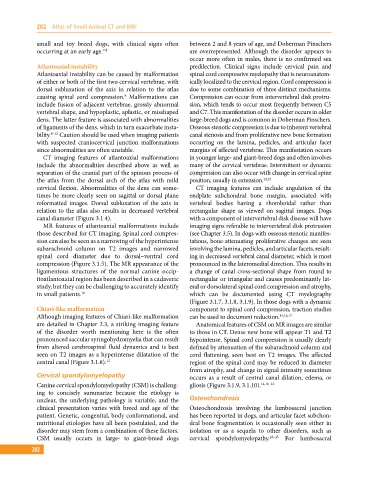Page 292 - Atlas of Small Animal CT and MRI
P. 292
282 Atlas of Small Animal CT and MRI
small and toy breed dogs, with clinical signs often between 2 and 8 years of age, and Doberman Pinschers
occurring at an early age. 7,8 are overrepresented. Although the disorder appears to
occur more often in males, there is no confirmed sex
Atlantoaxial instability predilection. Clinical signs include cervical pain and
Atlantoaxial instability can be caused by malformation spinal cord compressive myelopathy that is neuroanatom
of either or both of the first two cervical vertebrae, with ically localized to the cervical region. Cord compression is
dorsal subluxation of the axis in relation to the atlas due to some combination of three distinct mechanisms.
8
causing spinal cord compression. Malformations can Compression can occur from intervertebral disk protru
include fusion of adjacent vertebrae, grossly abnormal sion, which tends to occur most frequently between C5
vertebral shape, and hypoplastic, aplastic, or misshaped and C7. This manifestation of the disorder occurs in older
dens. The latter feature is associated with abnormalities large‐breed dogs and is common in Doberman Pinschers.
of ligaments of the dens, which in turn exacerbate insta Osseous stenotic compression is due to inherent vertebral
bility. 8–12 Caution should be used when imaging patients canal stenosis and from proliferative new bone formation
with suspected craniocervical junction malformations occurring on the lamina, pedicles, and articular facet
since abnormalities are often unstable. margins of affected vertebrae. This manifestation occurs
CT imaging features of atlantoaxial malformations in younger large‐ and giant‐breed dogs and often involves
include the abnormalities described above as well as many of the cervical vertebrae. Intermittent or dynamic
separation of the cranial part of the spinous process of compression can also occur with change in cervical spine
the atlas from the dorsal arch of the atlas with mild position, usually in extension. 14,15
cervical flexion. Abnormalities of the dens can some CT imaging features can include angulation of the
times be more clearly seen on sagittal or dorsal plane endplate subchondral bone margin, associated with
reformatted images. Dorsal subluxation of the axis in vertebral bodies having a rhomboidal rather than
relation to the atlas also results in decreased vertebral rectangular shape as viewed on sagittal images. Dogs
canal diameter (Figure 3.1.4). with a component of intervertebral disk disease will have
MR features of atlantoaxial malformations include imaging signs referable to intervertebral disk protrusion
those described for CT imaging. Spinal cord compres (see Chapter 3.5). In dogs with osseous stenotic manifes
sion can also be seen as a narrowing of the hyperintense tations, bone‐attenuating proliferative changes are seen
subarachnoid column on T2 images and narrowed involving the lamina, pedicles, and articular facets, result
spinal cord diameter due to dorsal–ventral cord ing in decreased vertebral canal diameter, which is most
compression (Figure 3.1.5). The MR appearance of the pronounced in the lateromedial direction. This results in
ligamentous structures of the normal canine occip a change of canal cross‐sectional shape from round to
itoatlantoaxial region has been described in a cadaveric rectangular or triangular and causes predominantly lat
study, but they can be challenging to accurately identify eral or dorsolateral spinal cord compression and atrophy,
in small patients. 10 which can be documented using CT myelography
(Figure 3.1.7, 3.1.8, 3.1.9). In those dogs with a dynamic
Chiari‐like malformation component to spinal cord compression, traction studies
Although imaging features of Chiari‐like malformation can be used to document reduction. 14,16,17
are detailed in Chapter 2.3, a striking imaging feature Anatomical features of CSM on MR images are similar
of the disorder worth mentioning here is the often to those in CT. Dense new bone will appear T1 and T2
pronounced saccular syringohydromyelia that can result hypointense. Spinal cord compression is usually clearly
from altered cerebrospinal fluid dynamics and is best defined by attenuation of the subarachnoid column and
seen on T2 images as a hyperintense dilatation of the cord flattening, seen best on T2 images. The affected
central canal (Figure 3.1.6). 13 region of the spinal cord may be reduced in diameter
from atrophy, and change in signal intensity sometimes
Cervical spondylomyelopathy occurs as a result of central canal dilation, edema, or
Canine cervical spondylomyelopathy (CSM) is challeng gliosis (Figure 3.1.9, 3.1.10). 14,18–22
ing to concisely summarize because the etiology is
unclear, the underlying pathology is variable, and the Osteochondrosis
clinical presentation varies with breed and age of the Osteochondrosis involving the lumbosacral junction
patient. Genetic, congenital, body conformational, and has been reported in dogs, and articular facet subchon
nutritional etiologies have all been postulated, and the dral bone fragmentation is occasionally seen either in
disorder may stem from a combination of these factors. isolation or as a sequela to other disorders, such as
CSM usually occurs in large‐ to giant‐breed dogs cervical spondylomyelopathy. 23–25 For lumbosacral
282

